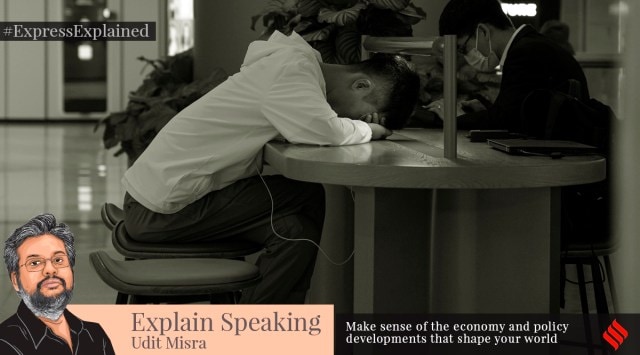ExplainSpeaking: Anatomy of China’s economic slowdown
Analysts and economists are revising down China's economic growth rate even as the People’s Bank of China has repeatedly cut interest rates. What is driving China's economic slowdown?
 A man takes a nap next to another browsing tablet computer at a cafe inside a shopping mall in Beijing on May 24, 2023. China’s consumer and factory activity weakened in May and record-breaking unemployment among young people in cities rose as an economic rebound following the end of anti-virus controls slowed. (AP Photo/Andy Wong)
A man takes a nap next to another browsing tablet computer at a cafe inside a shopping mall in Beijing on May 24, 2023. China’s consumer and factory activity weakened in May and record-breaking unemployment among young people in cities rose as an economic rebound following the end of anti-virus controls slowed. (AP Photo/Andy Wong) Dear Readers,
Much of India’s focus is justifiably on Prime Minister Modi’s forthcoming visit to the US. The move is likely to bring the two big economies even closer. Yet, last week was also a period of distinct activity to the east of India. News coming out of Beijing is that policymakers are increasingly worried about the health of the world’s second largest economy.
Last week, the People’s Bank of China — similar to the RBI in India — surprised everyone by twice cutting interest rates. First it cut the short-term lending rates last Tuesday and that set the stage for a cut of the medium-term lending rate on Thursday. What’s more, it is expected that as you are reading this, China will witness more tinkering on the interest rate front on June 20.
Why are interest rates being cut?
Cuts in interest rates are typically undertaken when policymakers are concerned about the growth outlook and want to incentivise economic activity. Lower interest rates make it cheaper and more affordable to take a fresh loan and consume more (read buying goods and services such as cars and houses).
Last week saw several economists and analysts across the board cut China’s growth forecast. This included JP Morgan, UBS, StanChart and Nomura. All of them trimmed China’s growth outlook from being closer to 6% to being closer to 5%.
Isn’t China bothered about containing inflation?
Cutting interest rates sounds strange in recent times since the world over policymakers have been more bothered about containing inflation by raising interest rates. Most central banks have been aggressively raising interest rates.
However, China has been in quite a unique position.
Unlike the rest of the world, which suffered average inflation rates of 8.7% (in 2022) and 7% in the current year, China had witnessed an inflation rate barely touching 2%. As such, its policymakers have not had the worries of containing inflation. Their problem is increasingly about sustaining China’s economic growth momentum.
How grave is the threat to China’s growth momentum?
The first thing to understand is that China’s annual GDP is around $19.3 trillion. That means, each year, China produces goods and services with a market value of over $19 trillion. That means, if China grows at 5%, which is its official target rate of growth, it will produce an additional GDP of close to $1 trillion. For perspective, India’s GDP is around $3.7 trillion.
However, several metrics released over the past two months are starting to worry analysts and Chinese policymakers.
Table 1 alongside details six key metrics that analysts look at while evaluating China’s future growth prospects.
 Source: China’s National Bureau of Statistics
Source: China’s National Bureau of Statistics
#1: Youth unemployment in urban areas: As the table shows, this key metric, which looks at unemployment among those aged between 16 and 24 has not only been 3-4 times the overall unemployment level, but also rising alarmingly. In May, it clocked almost 21% — that means, one in five Chinese youth is seeking work and failing to get it. It points to the lack of jobs and a substantial slowdown in the underlying economy.
#2: Growth in industrial output: At the start of the year, there was some hope that China was starting to pick up growth momentum. This was also crucial for global growth as well as growth among Asian countries. But the momentum seems to be faltering in May.
#3: Growth rate of investment in fixed assets: More investments in fixed assets suggest that firms are hopeful of future growth. Faltering growth rate here suggests underlying demand is weak and businesses are increasing holding back. At 4% growth rate, May saw the lowest growth rate in a year’s time.
#4: Growth rate of retail sales by consumers: As world trade falters, Chinese policymakers have been trying to transform their economy into one which runs more and more on domestic consumers. India, for example, depends heavily on domestic consumption and this has been a weakness in the recent years. Data here suggests that consumer growth rate faltered in May.
#5: Purchasing Managers’ Index (PMI) in the manufacturing sector: The PMI trend is used for international comparisons when one is monitoring macroeconomic developments. It is often seen as a strong predictor and can warn forthcoming slowdowns. The cut-off point is 50%. PMI above 50% reflects that the manufacturing economy is expanding; if it is less than 50%, it reflects the manufacturing economy is shrinking. It has now been in the negative territory for two consecutive months.
#6: PMI for non-manufacturing businesses: While not yet in the negative territory, the strength of the trend has weakened.
What to expect next?
As things stand, Chinese authorities are only tinkering with the interest rates but most analysts believe that the government will have to join forces and provide some kind of fiscal stimulus. In other words, merely reducing interest rates will not be enough to lift the Chinese economy and the government will either have to spend some money or cut some taxes to incentivise economic activity.
The fiscal stimulus, however, may come only by July.
See you tomorrow,
Udit








































